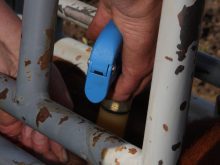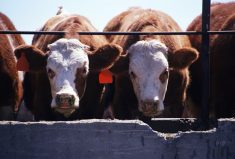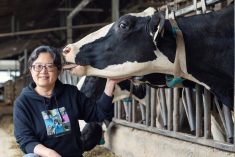Efficiencies in cattle production and feeding have allowed Canada’s beef industry to produce the same weight in beef as 30 years ago with smaller breeding herds, less land — and smaller greenhouse gas (GHG) output, a new study finds.
The study, led by research scientist Tim McAllister of Agriculture and Agri-Food Canada in Lethbridge, with staff from AAFC, Environment Canada and the University of Manitoba, logs a “significant reduction in GHG intensity” when comparing 2011 figures with those from 1981.
The first results from the five-year (2013-18) study, published Dec. 23 in the journal Animal Production Science, credit “continual improvements in production and feed efficiencies, crop yields and management strategies.”
Read Also

U.S. livestock: Cattle strength continues
Cattle futures on the Chicago Mercantile Exchange were stronger on Friday, hitting fresh highs to end the week.
GHG emissions have long been a contentious issue for the livestock sector. According to the Canadian Roundtable for Sustainable Beef (CRSB) in a release Monday, Canada’s beef industry today accounts for 3.6 per cent of Canada’s greenhouse gas production and 0.072 per cent of global greenhouse gas production.
At the same time, lands that grow grasses and legumes for cattle sequester carbon, thereby reducing GHGs, the group said.
GHG emissions in the study were estimated using life-cycle assessments (cradle to farm gate) based mainly on Holos, a Canadian whole-farm emissions model, the researchers wrote in their paper.
Compared with 1981, in 2011 the same amount of slaughter weight was produced, with a 14 per cent decline in methane emissions, 15 per cent decline in nitrous dioxide emissions and a 12 per cent decline in carbon dioxide emissions from fossil fuel use.
Enteric methane production — that is, from the animals’ digestive systems — accounted for 73 per cent of total GHG emissions in both years.
In all, the study found, the estimated intensity of GHG emissions per kilogram of live weight that left the farm was 14 kilograms of carbon dioxide equivalents for 1981, but 12 kg of carbon dioxide equivalents for 2011, down 14 per cent.
Past that, the study found that in 2011, beef production in Canada required only 71 per cent of the breeding herd (such as cows, bulls, calves and replacement heifers) and 76 per cent of the land needed to produce the same amount of live weight for slaughter as in 1981.
“We’re working to get a more accurate assessment of the Canadian beef industry’s environmental footprint and these results indicate that the footprint per kilogram of beef produced is getting smaller,” McAllister said in Monday’s release from the CRSB and Beef Cattle Research Council (BCRC).
The needed production and feed efficiencies, crop yields and improved management practices “wouldn’t have happened if it weren’t for investments in research and development, and the industry’s ability to adopt those technologies,” he said.
Those investments led to increased average daily gain and slaughter weight, improved reproductive efficiency, reduced time to slaughter, increased crop yields and a shift towards high-grain diets that enabled cattle to be marketed at an earlier age, the researchers said in their paper.
However, in terms of the industry’s overall sustainability, they wrote, “future studies are necessary to examine the impact of beef production on other sustainability metrics, including water use, air quality, biodiversity and provision of ecosystems services.”
“Perceived” concerns about the beef sector’s environmental impacts “often overshadow the beneficial impacts of the beef industry,” BCRC chair Tim Oleksyn, a cow-calf producer from Shellbrook in northern Saskatchewan, said in Monday’s release.
Beef producers, he said, are “inherently motivated to be more efficient, which most often has social, economic and environmental benefits. Now that we have resource use and GHG emission benchmarks, we can move forward as an industry and more strategically target our efforts to improve.”
The CRSB’s sustainability assessment is expected to benchmark the industry’s social, economic and environmental impact, using 2013 as the baseline, and to be revisited and evaluated every five years.
Results from the remaining phases of the industry environmental footprint study are expected in 2018, the CRSB said. — AGCanada.com Network
















